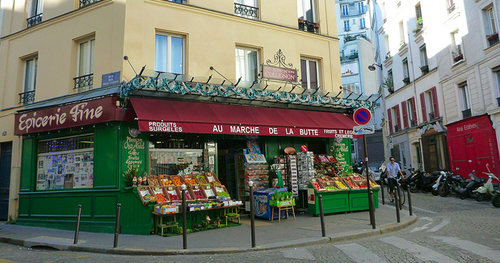
Americans are not very familiar with Arabs and Muslims, on the whole, and tend to regard them as foreign and possibly threatening. But that is not the case in France. For starters, there are lots of "Arabs" in France; ten percent of the population is Muslim, quite a few more than are Protestant (2%). Most of the picturesque little grocery shops like the one above are run by "Arabs" (actually in Paris they are usually North African Berbers, who do speak Arabic). They are open much longer hours than when they were run by French people, in my experience.
Although there are many French Muslims, they are not yet completely Frenchified and are not seen as 100% French by large segments of the rest of the population. I would say they are in much the same situation in France that, for example, Italian-Americans were in the U.S. in the 1930s and 1940s.
As a result of the large Muslim(ish) population, French people do not find the Arab world as odd and threatening as Americans do. For one thing they are a lot closer to it and have often visited it. Morocco, Tunisia and Algeria are part of the family history of many French families; others just go there on holiday. Colonial French Muslims fought and died in World War I for the French, and as partial thanks, the French government built them a lovely mosque in Paris, which stands in the fifth arrondissement near the Jardin des Plantes. It's a friendly place, open to all and not at all fundamentalist. There's a hammam, and a salon de thé popular with students from the nearby Sorbonne/Université de Paris, with delicious pastries, hot mint tea, an outdoor terrace and a series of indoor rooms that will make you feel you're in Morocco.

This is the entrance to the salon de thé around the side of the mosque Another place to learn about the Arab world in Paris is the Institut du Monde Arabe, which stands on the quai not far from Notre-Dame.

This is the courtyard side of the Institut.
It is designed with moucharabiyeh windows like those which make old houses in the middle east more comfortable; these are designed to contract and expand according to the light coming in. I don't know if they actually do any more.

What they look like on the inside Inside the building, which is open to the public, there is a small museum, classrooms for taking Arabic classes, a movie theater for showing Arabic movies, and exhibition spaces. There is a literary café for lectures, and a restaurant, open for lunch. If that's not enough to make you visit, check out the view from the roof!


